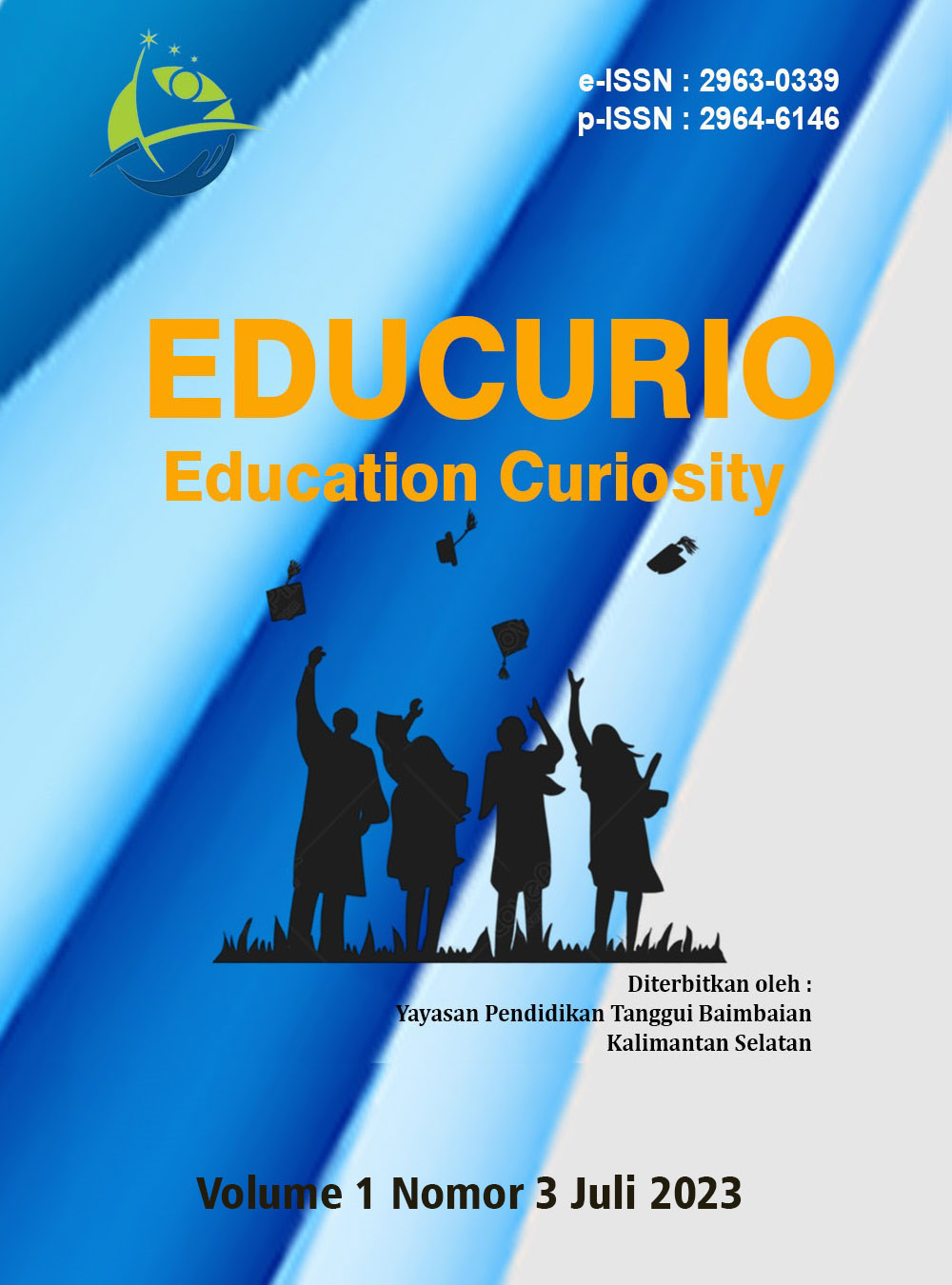Gestur Guru Dalam Mengajar Bahasa Inggris Di Sekolah Menengah Pertama
DOI:
https://doi.org/10.71456/ecu.v1i3.567Keywords:
Komunikasi nonverbal, Gestur guru, Pengajaran bahasa InggrisAbstract
Penelitian ini bertujuan untuk mengetahui tipe-tipe gestur guru yang digunakan oleh 2 (dua) orang guru bahasa Inggris di SMP N 1 Pariaman. Dalam menentukan partisipan, peneliti menggunakan total sampling teknik. Jadi, Peneliti menetapkan kedua orang guru tersebut menjadi partisipan dalam penelitian ini. Teknik pengumpulan data yang digunakan dalam penelitian ini adalah observasi dan vidio rekaman. Kedua instrument tersebut digunakan untuk melihat tipe-tipe gestur guru dan bagaimana cara penggunaanya oleh guru SMP N 1 Pariaman. Hal pertama yang dilakukan oleh peneliti adalah melakukan observasi dengan menggunakan vidio rekaman, observasi ceklis sebagai alat selama observasi. Berdasarkan observasi yang telah dilakukan ditemukan bahwa guru di SMP N 1 Pariaman menggunakan gestur guru dalam proses belajar mengajar. Gestur yang digunakan guru pertama adalah gestur ikonik, gestur deiktik dan gestur beat. Sedangkan guru kedua adalah gestur ikonik, gestur metafora, dan gestur deiktik.
References
Adler, R. B., & Rodman, G. (2006). Understanding Human Communication. In Archetypal Explorations. https://doi.org/10.4324/9780203360149_chapter_10
Afdaliah, N. (2022). Teachers’ Gestures in EFL Classroom. Al-Lisan, 7(2), 182–197. https://doi.org/10.30603/al.v7i2.2735
Alibali, M. W., & Nathan, M. J. (2012). Embodiment in Mathematics Teaching and Learning: Evidence From Learners’ and Teachers’ Gestures. Journal of the Learning Sciences, 21(2), 247–286. https://doi.org/10.1080/10508406.2011.611446
Brandt, C. (2012). Success on Your Certificate Course in English Language Teaching: A Guide to Becoming a Teacher in ELT/TESOL. In Success on Your Certificate Course in English Language Teaching: A Guide to Becoming a Teacher in ELT/TESOL. https://doi.org/10.4135/9781446213414
Coulthard, M. (2013). Advances in spoken discourse analysis. In Advances in Spoken Discourse Analysis. https://doi.org/10.4324/9780203200063
Creswell, J. W. (2012). Educational Research: Planning, Conducting, and Evaluating Quantitative and Qualitative Research. In Nucl. Phys.
Ekman, P., & Friesen, W. V. (2013). The repertoire of nonverbal behavior: Categories, origins, usage, and coding. Mouton Classics: From Syntax to Cognition. From Phonology to Text, 819–868. https://doi.org/10.1515/semi.1969.1.1.49
Gay, L. R., Mills, G. E., & Airasian, P. (2000). Educational Research Competencies for Analysis and Applications. Pearson, Columbus.
Hall, J. A., Horgan, T. G., & Murphy, N. A. (2019). Nonverbal Communication. Annual Review of Psychology, 70, 271–294. https://doi.org/10.1146/annurev-psych-010418-103145
Haneef, M., Faisal, M. A., Alvi, A. K., & Zulfiqar, M. (2014). the Role of Non-Verbal Communication in Teaching Practice. Sci.Int.(Lahore), 26(1), 513–517.
Iwe, N. (2021). Factors in Teachers’ Awareness of Pedagogical Gestures as Enhancement Technique Among English Teachers in Secondary Schools in Enugu State, Nigeria. African Journal of Teacher Education, 10(1), 222–241. https://doi.org/10.21083/ajote.v10i1.6573
Mcneill, D. (1992). Gesture: a psycholinguistic approach 1. 1–15.
Mehrabian. (1972). The puzzle of non verbal communication : Towards a new aspect of leadership.
Rahmat, A. (2018). Teachers ’ Gesture in Teaching EFL Classroom of Makassar State University. 2(2), 236–252. https://doi.org/10.31002/metathesis.v2i2.893
Sari, S. Y. (n.d.). A Study on Lecturer ’ s Gestures in the EFL Classroom Context Muhammad Basri Djafar Kisman Salija State University of Makassar , Indonesia. 1–16.
Wang, Z. (2012). Enquiry into Cultivating Intercultural Nonverbal Communicative Competence in College English Teaching. 2(6), 1230–1235. https://doi.org/10.4304/tpls.2.6.1230-1235
Witt, P. L., & Wheeless, L. R. (1999). Nonverbal communication expectancies about teachers and enrollment behavior in distance learning. Communication Education, 48(2), 149–154. https://doi.org/10.1080/03634529909379162
Downloads
Published
How to Cite
Issue
Section
License
Copyright (c) 2023 Hilmiatul Husna Ghafur, Herfyna Asty, Hevriani Sevrika

This work is licensed under a Creative Commons Attribution 4.0 International License.
License and Copyright Agreement
- Authors retain copyright and other proprietary rights related to the article.
- Authors retain the right and are permitted to use the substance of the article in their own future works, including lectures and books.
- Authors grant the journal the right of first publication with the work simultaneously licensed under Creative Commons Attribution License (CC BY 4.0) that allows others to share the work with an acknowledgment of the work's authorship and initial publication in this journal.
- Authors are able to enter into separate, additional contractual arrangements for the non-exclusive distribution of the journal's published version of the work (e.g., post it to an institutional repository or publish it in a book), with an acknowledgment of its initial publication in this journal.
- Authors are permitted and encouraged to post or self-archive their work online (e.g., in institutional repositories or on their website) prior to and during the submission process, as it can lead to productive exchanges, as well as earlier and greater citation of published work.












